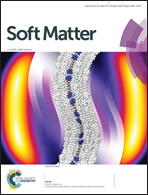A temperature-responsive supramolecular hydrogel: preparation, gel–gel transition and molecular aggregation
Abstract
In this study, a novel supramolecular hydrogel, abbreviated as AGC16/NTS, was designed and constructed by the molecular self-assembly of a cationic gemini surfactant, 1,3-bis(N,N-dimethyl-N-cetylammonium)-2-propylacrylatedibromide (AGC16), and an anionic aromatic gelator, trisodium 1,3,6-naphthalenetrisulfonate (NTS). The AGC16/NTS hydrogel was able to form in a mass ratio range of AGC16 and NTS from 20 : 1 to 10 : 1. It was interestingly found that AGC16/NTS exhibited two phase transitions (gel-to-gel and gel-to-sol) observed by visual and rheological measurements during the heating process, which is rarely reported in the previous literature reports of hydrogels prepared using low molecular weight gelators. Cryogenic scanning electron microscopy (cryo-SEM), fluorescence emission spectroscopy and X-ray diffraction (XRD) were used to investigate the temperature-responsive properties and molecular self-assembly mechanism of the hydrogel AGC16/NTS. During the gel-to-gel transition process, the temperature-responsive changes in the visual appearance of AGC16/NTS (turbid to transparent) were clearly observed. Compared with the transparent gel, the turbid gel possesses higher mechanical strength and a much more compact network mophology due to stronger intermolecular hydrophobic association beetween gelators. The molecular self-assembly modes for the two different hydrogel states (turbid and transparent gel) were proposed, helping to further understand the hydrogel transition mechanisms at a molecular level.



 Please wait while we load your content...
Please wait while we load your content...